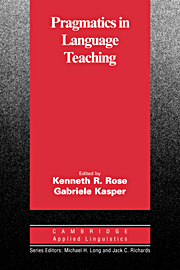Book contents
- Frontmatter
- Contents
- List of contributors
- Series editors' preface
- Preface
- Chapter 1 Pragmatics in language teaching
- I THEORETICAL AND EMPIRICAL BACKGROUND
- II ISSUES IN CLASSROOM-BASED LEARNING OF PRAGMATICS
- III THE EFFECTS OF INSTRUCTION IN PRAGMATICS
- IV THE ASSESSMENT OF PRAGMATIC ABILITY
- References
- Name index
- Subject index
Chapter 1 - Pragmatics in language teaching
Published online by Cambridge University Press: 05 October 2012
- Frontmatter
- Contents
- List of contributors
- Series editors' preface
- Preface
- Chapter 1 Pragmatics in language teaching
- I THEORETICAL AND EMPIRICAL BACKGROUND
- II ISSUES IN CLASSROOM-BASED LEARNING OF PRAGMATICS
- III THE EFFECTS OF INSTRUCTION IN PRAGMATICS
- IV THE ASSESSMENT OF PRAGMATIC ABILITY
- References
- Name index
- Subject index
Summary
Introduction
By such milestones as the appearance of the Threshold Level for English (Van Ek, 1975) and Wilkins's Notional Syllabus (1976), communicative language teaching (CLT) has been with us for nearly three decades. A strong theoretical impetus for the development of CLT came from the social sciences and humanities outside language pedagogy. Different notions of communicative competence, proposed by Hymes from the perspective of linguistic anthropology (1971) and by Habermas (1984) from the vantage point of social philosophy, served as guiding constructs for the design of communicative competence as the overall goal of language teaching and assessment. An influential and comprehensive review of communicative competence and related notions was offered by Canale and Swain (1980), who also proposed a widely cited framework of communicative competence for language instruction and testing. While pragmatics does not figure as a term among their three components of communicative competence (grammatical, sociolinguistic, and strategic competence), pragmatic ability is included under “sociolinguistic competence,” called “rules of use.” Canale (1983) expanded the earlier version of the framework by adding discourse competence as a fourth component. A decade after the original framework had been published, Bachman (1990, pp. 87ff.) suggested a model of communicative ability that not only includes pragmatic competence as one of the two main components of “language competence,” parallel to “organizational competence,” but subsumes “sociolinguistic competence” and “illocutionary competence” under pragmatic competence. The prominence of pragmatic ability has been maintained in a revision of this model by Bachman and Palmer (1996, pp. 66ff.).
- Type
- Chapter
- Information
- Pragmatics in Language Teaching , pp. 1 - 10Publisher: Cambridge University PressPrint publication year: 2001
- 62
- Cited by



